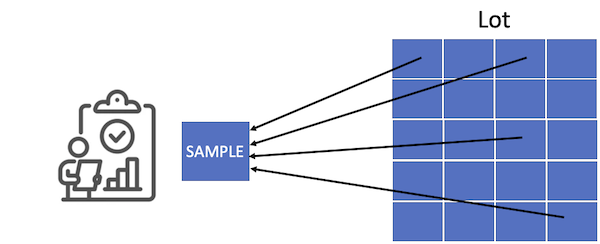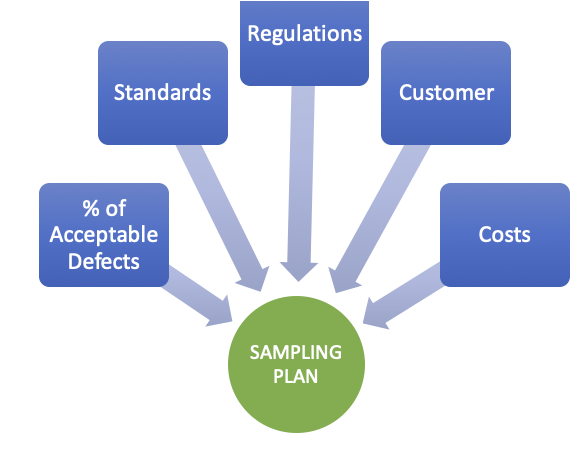
Ensuring the quality of components (whether these components are produced by the company or bought in from suppliers) is a vital activity for most businesses and an intrinsic part of the quality control process.
While inspections form a significant part of this activity, carrying out 100% inspection on everything is at best challenging and, at its worst unsustainable (especially in a high-volume industry).
As a result, many organizations utilize sampling to ascertain levels of quality.
A sampling plan enables an organization to assess and determine the quality of parts and products by evaluating only a percentage of the overall quantity available and then, using the results of that assessment, reach conclusions regarding the quality of the overall batch.
In today’s article, we’ll be looking at the role of a sampling plan in Quality Control; we’ll be covering:
- What is a sampling plan in Quality Control?
- Types of Sampling in Quality Control
- Purpose of sample plans in Quality Control
- Who uses sample plans in Quality Control?
- When To Use A Sampling Plan In Quality Control
- Considerations for Sample plans in Quality Control
- Benefits of sample plans in Quality Control
- Issues with sample plans in Quality Control
What is a sampling plan in Quality Control?
Assessing the quality of materials is nothing new and, as we described in our introduction, is a key component of a business’s quality function.
These materials may take the form of goods manufactured by the business itself or those bought in from third parties via the supply chain.
Most businesses have processes and policies that describe the methods to be used to assess parts.
This often takes the form of physical inspection (which can be just physical measurement combined with verification checks on documentation or involve other processes such as destructive testing) in order to determine levels of quality.
A sampling plan is a technique used to determine quality by observing and assessing only a proportion of product/materials rather than 100% of the total quantity.
Sampling is a concession between 0% inspection and 100% inspection, levels of quality are inferred based on assessing only a percentage of the complete lot.
This concession is made due to business drivers (such as cost).
As its name implies, a sampling plan is a statistical technique which we can use to help us decide if we can accept or reject material.
In practice, this means that
- We assess a small number of units to ensure compliance with standards/requirements
- We then infer the quality standards of the lot
- We use the results to determine if we can accept the lot
There are various reasons for doing this. Assessing and inspecting materials takes time, resources and cost. By making the process more efficient, savings can be made.
Where an organization has procured 5 garments, it may make sense to undertake a 100% inspection to ascertain quality standards.
Where the organization has procured 50,000, it may make sense to undertake sampling in order to measure quality more cost-effectively.
Types of Sampling in Quality Control
Rather than a singular method for sampling, there are a number of alternative methods that can be used;
Statistical
Most organizations, when using a statistical approach, will utilize the AQL limit; you’ll see this sometimes called Acceptable Quality Limit or Acceptance Quality Limit.
For more in-depth detail on this, head on over to this excellent article https://qualityinspection.org/what-is-the-aql/#aql-tables
In practice, AQL is regarded as the worst quality level that is still considered satisfactory or another way of putting it: the maximum percentage allowed to be defective for the lot to be deemed acceptable.
While you can, of course, know the math, most companies will use an AQL table that provides guidance on the statistical method used based on three key parameters
- The lot size under assessment
- The inspection level you might apply
- The level of acceptable defects for your market
Note this applies to the product only (and not associated things like packaging etc.).
By using the method, you will calculate the number of goods required for inspection.
Random
A random sample, sometimes called ad-hoc, is just that. We assess a certain percentage of the batch under investigation.
While this may represent an easy method – “we’ll just investigate 10%” this method doesn’t necessarily provide you with the confidence that the sample size is either correct or provides value to the inspector.

Random sampling faces several challenges, namely:
- Bias – was the selection truly random, or did the reviewer select the sample out of a particular bias?
- Dispersion – samples may not be representative of the spread of quality observable within a batch
- Inconsistency among samples – samples are not consistent with the overall quantity of product
First Off
First off, inspections are commonly carried out (often as part of an initial product run or where changes have been made to the production process). First off (as its name implies) – it assesses a sample of a produced lot, either the first or first few of a batch, to ensure that requirements and controls have been met.
Batch
In this method, a batch is assessed of being representative of a production run. A factory may make 10,000 widgets a week in batches of 500. A particular batch is selected in order to assess the quality and likelihood of non-conformance
Acceptance sampling
In this method, a manufacturer or producer will supply a number of completed goods to its customer in order that they can be reviewed and a decision made whether to accept or reject the overall batch. This method relies on sampling by deciding on the quantity of defective items from the sample and extrapolating that to the total batch. The customer will then decide if the quantity of defects falls into an acceptable range.
Purpose of sample plans in Quality Control
The ultimate purpose of using a sampling plan as part of your quality control process is to provide a view of the quality of components being reviewed.
We all know the implications of poor quality products, whether it’s the impact on the customer or increased costs of correction.
However, most businesses have significant quantities of products passing through their organization and inspecting every single one isn’t practical (from a cost or resource perspective).
Sample plans, therefore, provide a reasonable approach to most businesses, protecting quality whilst being an effective process that doesn’t drain resources or costs.
Who uses sample plans in Quality Control?
Sampling is widely used in businesses due to the benefits obtained when facing detrimental aspects of 100% inspection, such as:
- Destructive inspection where a quantity of product is destroyed during testing and a business wants to limit this
- Costs associated with 100% inspection are not economical
That being said, however, there may be some regulated industries where sampling is not appropriate (examples include businesses where defects may result in injury or death e.g. certain Aerospace/pharmaceuticals).
Also, businesses where product volumes are low, may refer back to 100% inspection.
When To Use A Sampling Plan In Quality Control
Using a sample plan is obviously at the discretion of the assessor. However, there are some things to think about when evaluating whether to use one:

- The level of defects you choose to (or are able to) accept – Not every industry will accept defects (think about Aerospace and Pharmaceuticals, which have a very low threshold, 0%, for defects as they may result in harm to life). Other industries might accept levels of defects that can support sample inspection.
- Your customer – Another consideration is the end customer and their appetite for defects. If we look at high-volume industries like the garment industry, there is an acceptance of levels (even if low) of defects. Other customers may require very high levels of quality, and your inspection processes will need to be tailored accordingly.
- Costs/Resource – If you are faced with large batch quantities (10,000’s of pieces, for example), assessing each individual unit is not cost-effective.
Considerations for Sample plans in Quality Control
In determining any Quality Control plan, planning ahead is always vitally important. Planning allows you to understand your goals and methods and bring out risks and considerations and help determine appropriate processes.
So, when you’re planning your sample plans, here are some considerations:
- Your objectives
- The impact of your end process
- Preexisting policies and standards
- The rationale behind the use of sampling
- Why are you rejecting other methods?
- Levels of accuracy required.
- Actual sample size vs safe sample size
- How reliable may your estimates be
- Variability of data and reasons for variation
Benefits of sample plans in Quality Control
As we’ve described, there are several benefits of sampling plans, these include:
- A well-recognized quality control method
- Helps reduce costs and administration associated with 100% inspection
- Reduced levels of destructive tests required where appropriate
- Reduces inspection fatigue which drives error on 100% inspection
- Utilizes a selection of methods that allows you to choose something suitable for your business
Issues with Sample plans in Quality Control
Issues include:
- Sampling is not a precise picture that could be achieved through 100% inspection
- Sampling doesn’t necessarily lead to 100% quality
- Samples may not be indicative of a lot
- Planning and documentation overhead
- This does not negate the need for good Quality characteristics and acceptance criteria
Summary
Assessing the quality of materials is an intrinsic component of any Quality function.
Whether materials are produced in-house or supplied by 3rd parties, validating that appropriate quality requirements have been met is fundamental.
While certain industries may take the view that 100% inspections are required, many will employ sample inspection programs.
Sampling represents a compromise between 0% inspection and 100% inspection; levels of quality can be extrapolated and established by testing an allocation of the entire quantity of product.
There are various benefits to executing inspections this way, cost and time being key. However, there are certain considerations that must be taken into account when undertaking this method.
Have you helped develop your organization’s sampling program? We’d love to hear about any lessons learned.
As ever, you can reach us on Twitter or via the comments section below.
